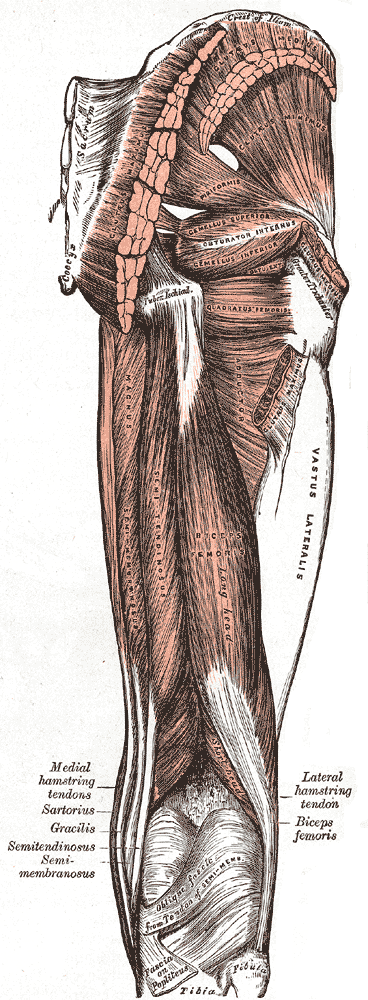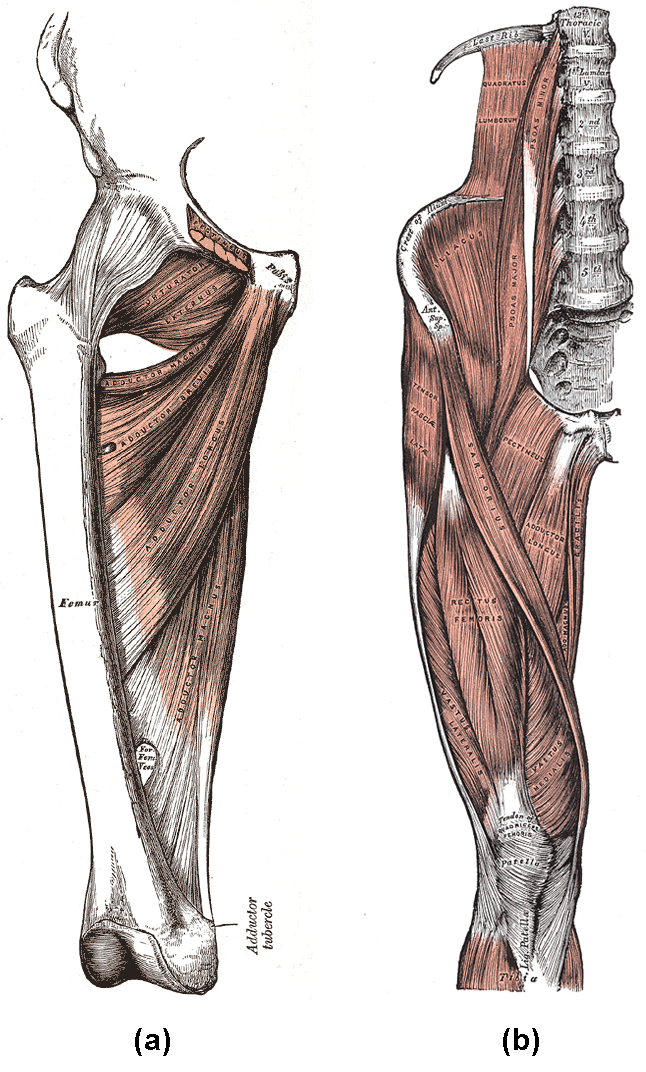9.10A: Muscles that Cause Movement at the Hip Joint
- Page ID
- 7569
\( \newcommand{\vecs}[1]{\overset { \scriptstyle \rightharpoonup} {\mathbf{#1}} } \)
\( \newcommand{\vecd}[1]{\overset{-\!-\!\rightharpoonup}{\vphantom{a}\smash {#1}}} \)
\( \newcommand{\id}{\mathrm{id}}\) \( \newcommand{\Span}{\mathrm{span}}\)
( \newcommand{\kernel}{\mathrm{null}\,}\) \( \newcommand{\range}{\mathrm{range}\,}\)
\( \newcommand{\RealPart}{\mathrm{Re}}\) \( \newcommand{\ImaginaryPart}{\mathrm{Im}}\)
\( \newcommand{\Argument}{\mathrm{Arg}}\) \( \newcommand{\norm}[1]{\| #1 \|}\)
\( \newcommand{\inner}[2]{\langle #1, #2 \rangle}\)
\( \newcommand{\Span}{\mathrm{span}}\)
\( \newcommand{\id}{\mathrm{id}}\)
\( \newcommand{\Span}{\mathrm{span}}\)
\( \newcommand{\kernel}{\mathrm{null}\,}\)
\( \newcommand{\range}{\mathrm{range}\,}\)
\( \newcommand{\RealPart}{\mathrm{Re}}\)
\( \newcommand{\ImaginaryPart}{\mathrm{Im}}\)
\( \newcommand{\Argument}{\mathrm{Arg}}\)
\( \newcommand{\norm}[1]{\| #1 \|}\)
\( \newcommand{\inner}[2]{\langle #1, #2 \rangle}\)
\( \newcommand{\Span}{\mathrm{span}}\) \( \newcommand{\AA}{\unicode[.8,0]{x212B}}\)
\( \newcommand{\vectorA}[1]{\vec{#1}} % arrow\)
\( \newcommand{\vectorAt}[1]{\vec{\text{#1}}} % arrow\)
\( \newcommand{\vectorB}[1]{\overset { \scriptstyle \rightharpoonup} {\mathbf{#1}} } \)
\( \newcommand{\vectorC}[1]{\textbf{#1}} \)
\( \newcommand{\vectorD}[1]{\overrightarrow{#1}} \)
\( \newcommand{\vectorDt}[1]{\overrightarrow{\text{#1}}} \)
\( \newcommand{\vectE}[1]{\overset{-\!-\!\rightharpoonup}{\vphantom{a}\smash{\mathbf {#1}}}} \)
\( \newcommand{\vecs}[1]{\overset { \scriptstyle \rightharpoonup} {\mathbf{#1}} } \)
\( \newcommand{\vecd}[1]{\overset{-\!-\!\rightharpoonup}{\vphantom{a}\smash {#1}}} \)
\(\newcommand{\avec}{\mathbf a}\) \(\newcommand{\bvec}{\mathbf b}\) \(\newcommand{\cvec}{\mathbf c}\) \(\newcommand{\dvec}{\mathbf d}\) \(\newcommand{\dtil}{\widetilde{\mathbf d}}\) \(\newcommand{\evec}{\mathbf e}\) \(\newcommand{\fvec}{\mathbf f}\) \(\newcommand{\nvec}{\mathbf n}\) \(\newcommand{\pvec}{\mathbf p}\) \(\newcommand{\qvec}{\mathbf q}\) \(\newcommand{\svec}{\mathbf s}\) \(\newcommand{\tvec}{\mathbf t}\) \(\newcommand{\uvec}{\mathbf u}\) \(\newcommand{\vvec}{\mathbf v}\) \(\newcommand{\wvec}{\mathbf w}\) \(\newcommand{\xvec}{\mathbf x}\) \(\newcommand{\yvec}{\mathbf y}\) \(\newcommand{\zvec}{\mathbf z}\) \(\newcommand{\rvec}{\mathbf r}\) \(\newcommand{\mvec}{\mathbf m}\) \(\newcommand{\zerovec}{\mathbf 0}\) \(\newcommand{\onevec}{\mathbf 1}\) \(\newcommand{\real}{\mathbb R}\) \(\newcommand{\twovec}[2]{\left[\begin{array}{r}#1 \\ #2 \end{array}\right]}\) \(\newcommand{\ctwovec}[2]{\left[\begin{array}{c}#1 \\ #2 \end{array}\right]}\) \(\newcommand{\threevec}[3]{\left[\begin{array}{r}#1 \\ #2 \\ #3 \end{array}\right]}\) \(\newcommand{\cthreevec}[3]{\left[\begin{array}{c}#1 \\ #2 \\ #3 \end{array}\right]}\) \(\newcommand{\fourvec}[4]{\left[\begin{array}{r}#1 \\ #2 \\ #3 \\ #4 \end{array}\right]}\) \(\newcommand{\cfourvec}[4]{\left[\begin{array}{c}#1 \\ #2 \\ #3 \\ #4 \end{array}\right]}\) \(\newcommand{\fivevec}[5]{\left[\begin{array}{r}#1 \\ #2 \\ #3 \\ #4 \\ #5 \\ \end{array}\right]}\) \(\newcommand{\cfivevec}[5]{\left[\begin{array}{c}#1 \\ #2 \\ #3 \\ #4 \\ #5 \\ \end{array}\right]}\) \(\newcommand{\mattwo}[4]{\left[\begin{array}{rr}#1 \amp #2 \\ #3 \amp #4 \\ \end{array}\right]}\) \(\newcommand{\laspan}[1]{\text{Span}\{#1\}}\) \(\newcommand{\bcal}{\cal B}\) \(\newcommand{\ccal}{\cal C}\) \(\newcommand{\scal}{\cal S}\) \(\newcommand{\wcal}{\cal W}\) \(\newcommand{\ecal}{\cal E}\) \(\newcommand{\coords}[2]{\left\{#1\right\}_{#2}}\) \(\newcommand{\gray}[1]{\color{gray}{#1}}\) \(\newcommand{\lgray}[1]{\color{lightgray}{#1}}\) \(\newcommand{\rank}{\operatorname{rank}}\) \(\newcommand{\row}{\text{Row}}\) \(\newcommand{\col}{\text{Col}}\) \(\renewcommand{\row}{\text{Row}}\) \(\newcommand{\nul}{\text{Nul}}\) \(\newcommand{\var}{\text{Var}}\) \(\newcommand{\corr}{\text{corr}}\) \(\newcommand{\len}[1]{\left|#1\right|}\) \(\newcommand{\bbar}{\overline{\bvec}}\) \(\newcommand{\bhat}{\widehat{\bvec}}\) \(\newcommand{\bperp}{\bvec^\perp}\) \(\newcommand{\xhat}{\widehat{\xvec}}\) \(\newcommand{\vhat}{\widehat{\vvec}}\) \(\newcommand{\uhat}{\widehat{\uvec}}\) \(\newcommand{\what}{\widehat{\wvec}}\) \(\newcommand{\Sighat}{\widehat{\Sigma}}\) \(\newcommand{\lt}{<}\) \(\newcommand{\gt}{>}\) \(\newcommand{\amp}{&}\) \(\definecolor{fillinmathshade}{gray}{0.9}\)The four main groups of hip muscles are gluteal, adductor, iliopsoas, and lateral rotator, defined by the type of movement they mediate.
- Differentiate among the muscles involved in moving the hip joint
Key Points
- The gluteus maximus extends the hip, while the gluteus medius and minimus are involved in hip rotation and abduction (moving hip out from the midline).
- The adductor group (adductor brevis, longus, and magnus along with petineus and gracilis) moves the femur towards the midline from an abducted position.
- The iliopsoas group of muscles (iliacus and psoas major) is responsible for hip flexion.
- The lateral rotator group of muscles (externus and internus obturators, the piriformis, the superior and inferior gemelli, and the quadratus femoris) turns the anterior surface of the femur outward. This motion is aided by the gluteus maximus and the adductor magnus.
Key Terms
- adductor group: The adductor brevis, adductor longus, adductor magnus, pectineus, and gracilis.
- lateral rotator group: The externus and internus obturators, the piriformis, the superior and inferior gemelli, and the quadratus femoris.
- gluteal group: The gluteus maximus, gluteus medius, gluteus minimus, and tensor fasciae latae.
- iliopsoas group: The iliacus and psoas major.
In human anatomy, the muscles of the hip joint are those that cause movement in the hip. Hip joint muscles are divided into four groups according to their orientation and function. Movement at the hip is similar to that of the shoulder joint, but due to increased weight-bearing requirements the range of potential movements is reduced.
Gluteal Group

Key muscles of the hip: The gluteus maximus can be seen at the top, cut away to expose the underlying muscles.
Muscles in the gluteal group are superficially located and act mainly to abduct and extend the thigh at the hip.
- Gluteus Maximus: The gluteus maximus is the largest of the gluteal muscles and gives structure to the buttocks.
- Attachments: Originates from the posterior of the pelvis and coccyx (tailbone) and attaches to the femur.
- Actions: Extends of the thigh and assists with rotation. Is only used when the generation of force is required (e.g. when climbing).
- Gluteus Medius: The fan-shaped gluteus medius muscle lies between the gluteus maximus and minimus and performs a similar function to the gluteus minimus.
- Attachments: Originates from the posterior of the pelvis and attaches to the femur.
- Actions: Abducts and medially rotates the thigh and fixes the pelvis during walking.
- Gluteus Minimus: The gluteus minimus is the deepest and smallest of the superficial gluteal muscles and performs a similar function to the gluteus medius.
- Attachments: Originates from the pelvis and attaches to the femur.
- Actions: Abducts and medially rotates the thigh and fixes the pelvis during walking.
Lateral Rotator Group
The muscles of the lateral rotator group are deeply located and as the name suggests, act to laterally rotate the thigh at the hip. All of the lateral rotator group muscles originate from the pelvis and attach to the femur.
- Piriformis: The piriformis is the most superior of the lateral rotator group muscles.
- Actions: Lateral rotation and abduction of the thigh at the hip.
- Obturator Internus: The obturator internus lines the internal wall of the pelvis.
- Actions: Lateral rotation and abduction of the thigh at the hip.
- Gemelli: The gemelli are two (superior and inferior) narrow and triangular muscles, separated by the obturator internus tendon.
- Actions: Lateral rotation and abduction of the thigh at the hip.
- Quadratus Femoris: The quadratus femoris is a flat, square-shaped muscle (actually composed of four distinct muscles). It is the most inferior of the lateral rotator group muscles, located below the gemelli and obturator internus.
- Actions: Lateral rotation of the thigh at the hip, plays a major role in extension of the lower leg at the knee as well.
Adductor Group

(a) Adductor Group Muscles and (b) Key muscles associated with movement at the hip: The deep-lying adductor group muscles originate from the pubis and attach to the length of the femur. The iliacus and psoas major comprise the iliopsoas group and can be seen at the pelvis and lower spine.
The five muscles of the adductor group are responsible for the adduction of the thigh, although several have additional functions.
- Adductor Longus: The adductor longus is a large, flat muscle covering the adductor magnus and adductor brevis.
- Attachments: Originates from the pubis and broadly attaches to the femur.
- Actions: Adduction and medial rotation of the thigh.
- Adductor Magnus: The adductor magnus is the largest and most posterior of the adductor group muscles.
- Attachments: Originates from the pubis and attaches to the femur.
- Actions: Adducts, flexes, and extends the thigh.
- Adductor Brevis: The adductor brevis is a short muscle lying underneath the adductor longus.
- Attachments: Originates from the pubis and attaches to the femur.
- Actions: Adduction of the thigh.
- Obturator Externus: This is one of the smaller muscles of the medial thigh, and it is located most superiorly.
- Attachments: Originates from the pubis and attaches to the femur.
- Actions: Laterally rotates the thigh.
- Gracilis: The gracilis is the most superficial and medial of the adductor group muscles. Crossing both the hip and knee joints, it can induce movement at both the hip and knee.
- Attachments: Originates from the pubis and attaches to the tibia.
- Actions: Adduction of the thigh at the hip, and flexing of the thigh at the knee.
Other Muscles
There are several other muscles that induce movement around the hip joint.
- Psoas Major: The psoas major is located deep in the back near the midline immediately adjacent to the spine. The iliacus and psoas major comprise the iliopsoas group.
- Attachments: Originates from the base of the spine, combining with the iliacus to attach to the femur.
- Actions: Flexing of the thigh at the hip joint.
- Iliacus: The iliacus muscle is a large, fan-shaped muscle which lines the interior of the pelvis. The iliacus and psoas major comprise the iliopsoas group.
- Attachments: Originates from the pelvis and the base of the spine, combining with the psoas major to attach to the femur.
- Actions: Flexing of the thigh at the hip joint.
- Sartorius: The sartorius is a long thin muscle in the thigh, the longest muscle in the body.
- Attachments: Originates from the pelvis and attaches to the tibia.
- Actions: Flexing, abducting and rotation of the thigh at the hip joint.
- Pectineus: The pectineus muscle is a large flat muscle found in the thigh.
- Attachments: Originates from the pelvis and attaches to the femur.
- Actions: Adduction and flexing at the thigh at the hip joint.
- Biceps Femoris: A similar muscle to the biceps brachii in the upper arm, also double-headed. Two synergistic muscles are associated with the biceps femoris, the semitendinosus, and the semimembranosus.
- Attachments: Originates from the pelvis and femur and attaches to the fibula.
- Actions: Extends and laterally rotates at the hip. The main action is flexing of the lower leg at the knee.
KEY MOVEMENTS
- Extension (bringing thigh behind body) Produced by the gluteus maximus, adductor magnus, and biceps femoris. Flexion (extending thigh to front of body): Produced by the gracilis, psoas major, iliacus, and pectineus.
- Abduction (moving thigh laterally away from pelvis): Produced by the gluteus medius and minimus, obturator externus, gemelli, and sartorius.
- Adduction (returning thigh to midline): Produced by the adductor group of muscles.
- Rotation (rotation of the thigh around the hip joint): Produced by the lateral rotator group of muscles and the biceps femoris, sartorius, and gluteus medius and minimus.

